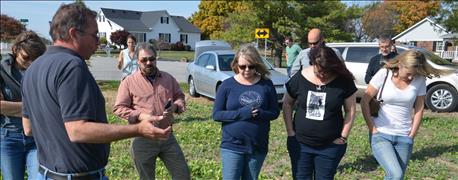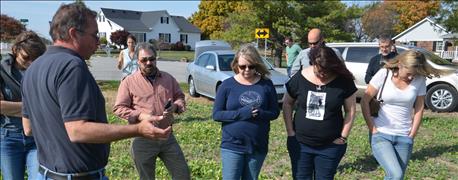
Pick a central location where everyone in Indiana would have a reasonable shot of attending a farm meeting during the day and your dart on the map would land pretty close to Brownsburg. Now all that’s needed is a meeting worth attending. With Mike Starkey hosting, this event won’t only be worth attending, but also promises to be exciting, entertaining and backed up by good food!

ON THE STUMP: Mike Starkey is in his element when he is teaching others about the value of no-till and cover crops. Join him on his Brownsburg farm for his sixth annual winter clinic on Dec. 20.
Starkey, Brownsburg, has opened up his farm to everyone from senators, gubernatorial candidates and the state secretary of agriculture to The Nature Conservancy personnel, EPA officials and the staff of the Indiana Division of Soil Conservation. But perhaps the most important people he invites to his farm, Starkey notes, are fellow farmers — especially those interested in conservation tillage, soil health and cover crops.
“We all learn from each other,” Starkey says. “That is what makes these meetings so interesting.”
Starkey’s annual winter clinic is Dec. 20, and you’re invited! He’s hoping to fill his farm shop with farmers who want to hear from other farmers and specialists who not only make conservation systems work, but also follow good agronomic practices in the process.
Top-notch speakers
Joe Nester has led discussion at Starkey’s clinics before. He is back by popular demand this year, Starkey says. Nester is an independent crop consultant who operates Nester Ag in Ohio. However, he also has clients in Indiana, including Starkey.
Nester will address two key topics. The first is recoverability of nutrients in a no-till system. This is something many people want to know more about, Starkey says. How many nutrients can you capture and recover with cover crops, and how quickly can you get them back into your soil system?
Nester will also directly address the nutrient benefits of cover crops. He has done considerable work with farmers who are in cover crop and no-till systems.
Jim Schwartz will also be on hand. With 32 years in the ag industry, he currently represents a fairly new company, 360 Yield Center. He will address timing of nitrogen needs in the corn plant.
Starkey used Y-Drops, offered by 360 Yield Center, successfully this year. He also used undercover nozzles, which are available on the Y-Drop system, to apply foliar nutrients and fungicides. Expect both Schwartz and Starkey to touch on these topics.
A.J. Adkins, territory manager for Dawn Biologic, will explain what’s new in no-till equipment. Bob Barr from Indiana University-Purdue University Indianapolis will update participants on environmental studies underway on Starkey’s farm. A long-term project to monitor nutrient runoff and gauge effectiveness of different fertilizer approaches is in its second year on Starkey’s farm.
Perhaps the highlight of the clinic will be a farmer panel discussion to close out the day. Right now, it only has 15 minutes on the program. “Hey, if they need a half-hour or more, we’ll find the time,” Starkey quips. “Farmers learn from farmers.”
Registration is $20 per person. The Hendricks County Soil and Water Conservation District is the official sponsor for the event. Call 317-745-2555, or register online.
About the Author(s)
You May Also Like




